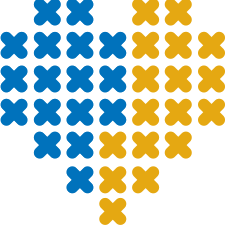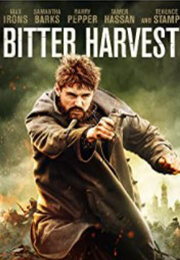Holodomor:
A Remembrance
87th Anniversary of the Holodomor Genocide in Ukraine
Art by Lydia Bodnar-Balahutrak
November 2020

About the Holodomor and Exhibition
The month of November is a somber time for Ukrainians around the world as they commemorate the 1932-33 famine-genocide — Holodomor. Murder by starvation is the literal translation from Ukrainian and depicts the horror inflicted by Stalin and his government officials on men, women and children in a deliberate political policy of extermination.
This was not a famine caused by natural factors — food was available. Yet Stalin ordered that all foodstuff and grain be expropriated in order to carry out rapid industrialization and to destroy the will of a nationally conscious Ukrainian peasantry. Millions of Ukrainians died of starvation while millions more were victims of Stalin’s bloody years of purges and repressions.
This year marks the 87th anniversary of this tragedy, occurring at a time when people worldwide are suffering from the effects of the COVID-19 pandemic, with thousands dying and falling ill. Even in the midst of these very difficult times, the horrors of the past cannot be forgotten. To honor the victims of the Holodomor, a virtual slideshow depicting 26 mixed media artworks of Houston-based Ukrainian-American artist Lydia Bodnar-Balahutrak, replaces an on-site exhibit.
The artworks featured are striking, compelling and filled with an anguish that roots viewers even if one wishes to avert their eyes. This is precisely the artist’s intent — we must look in order to honor the victims and to acknowledge the past so that we can move on. Throughout, titles provide clues to the meanings and symbolism of her work.
About the Artwork
The exhibit opens with Death: A Common Sight in Ukraine and captures the situation where villagers were starved by the millions while the Soviet government sold tons of confiscated grain to the West. Passports were not issued, and no one was allowed to leave. Photocopied and collaged into the lower right-hand corner of the artwork is a photo image of a corpse lying unburied in a farming field.
Another Crucifixion depicts a Holodomor child upon an iconographic Christian cross. The child’s image is copied from a historical archival photograph. Throughout, the artist’s use of varied materials adds even more layers of meaning as three concerns remain constant in her artwork: the use of collage or assemblage (three-dimensional pieces), using text and narratives, and images of nature which are usually superimposed over the collage.
When Ms. Bodnar-Balahutrak first visited her ancestral homeland in 1991, she stated that her eyes and soul were opened to a land that was beautiful but ravaged by the Soviet regime. The people were long-suffering yet hopeful — the culture was rich but sabotaged. Years of Soviet oppression had left their mark and were visible everywhere. Mass graves were being uncovered, revealing horrific historical events long denied by the Soviet government. This new knowledge of so many innocent victims did not pull her down into despair but rather created an urgent need to tell their stories — which was also her story. Not only did this travel experience change her world view, it also changed her approach to art making. She states:
“My art of loss and remembrance responds to the genocide waged by the Soviet regime against the Ukrainian nation and reflects my ancestral roots. Millions perished in Stalin’s orchestrated 1932-33 famine in Ukraine. Merging Holodomor victims’ images with icon conceits, I honor them.”

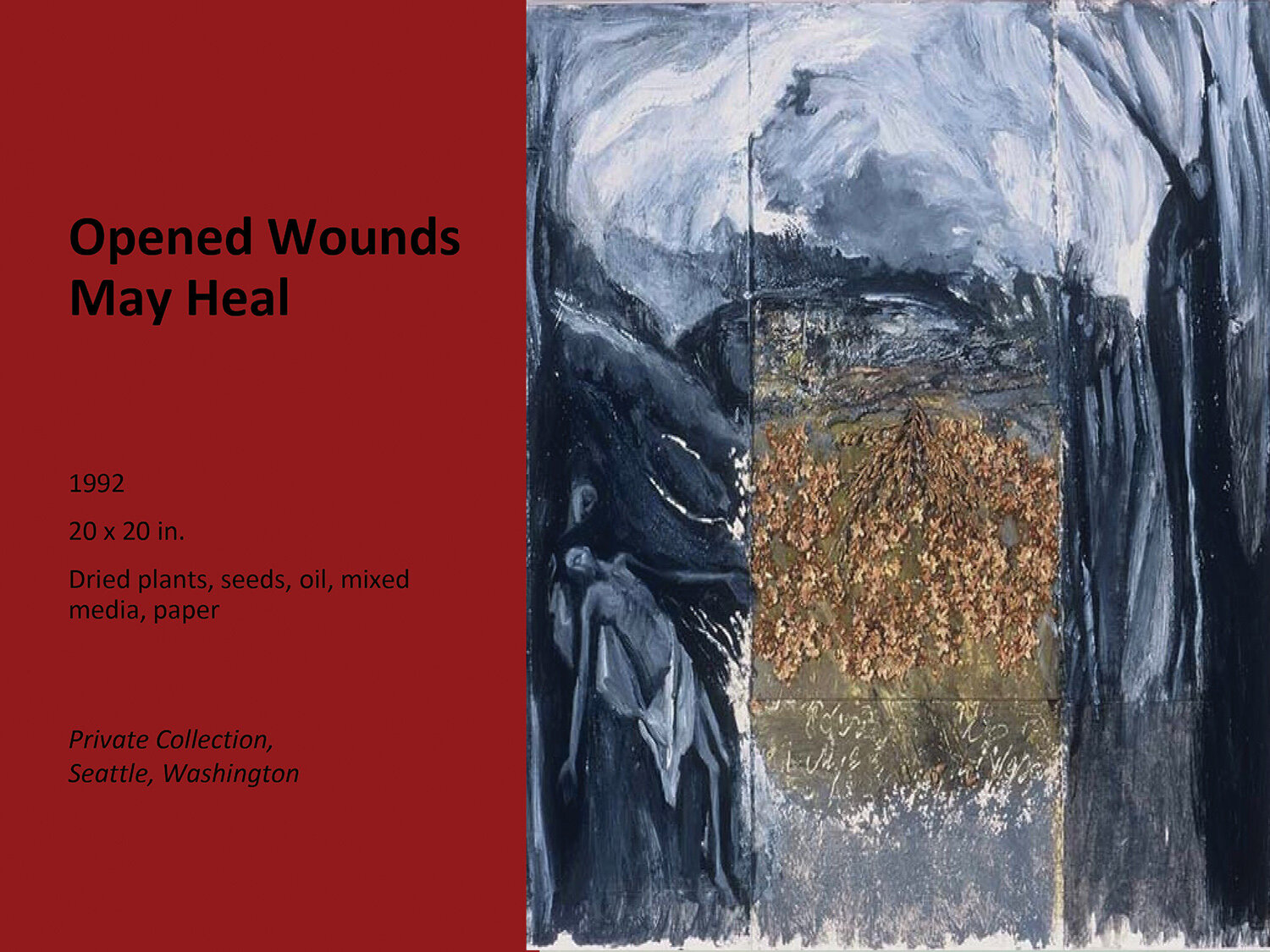

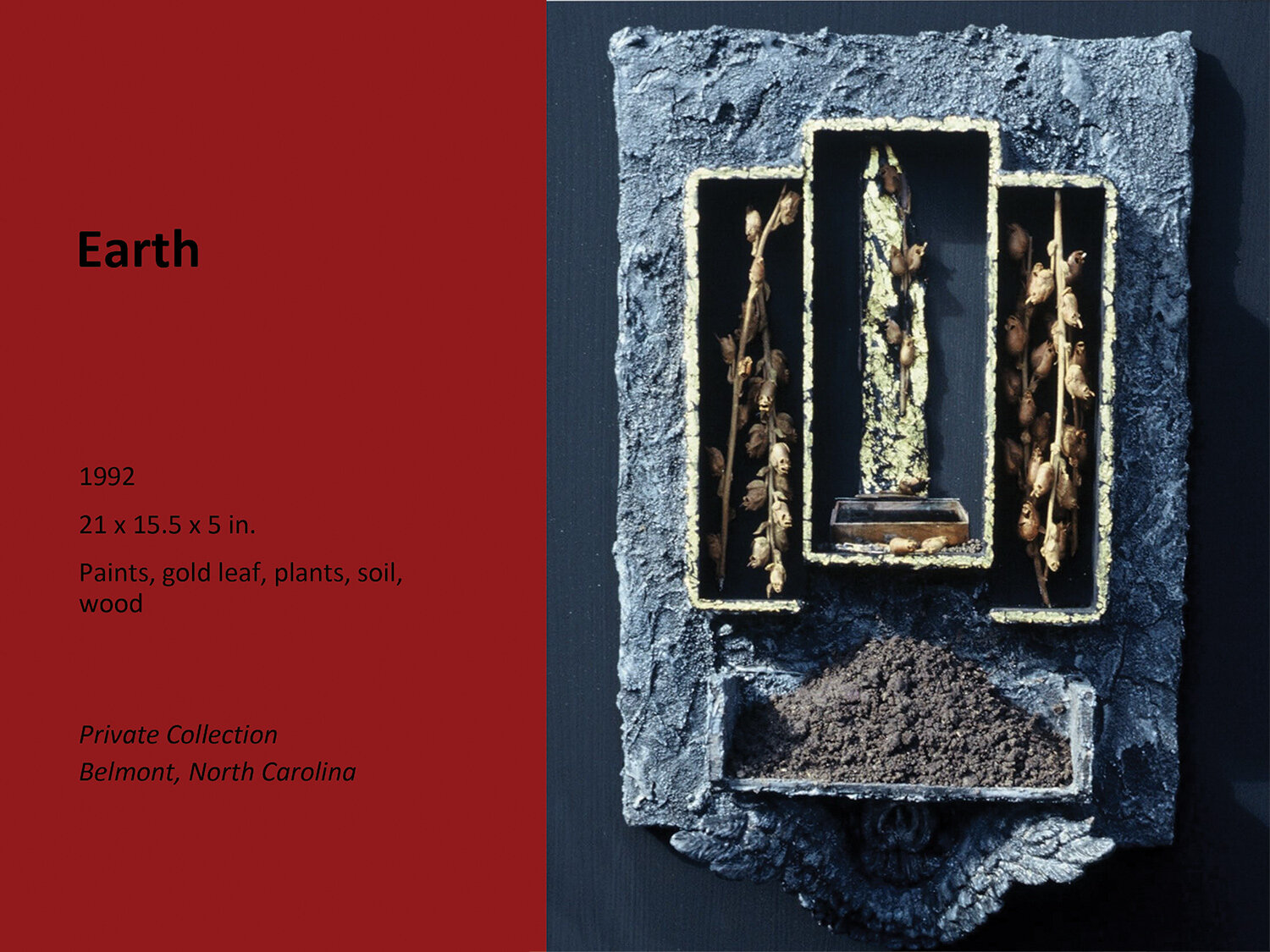


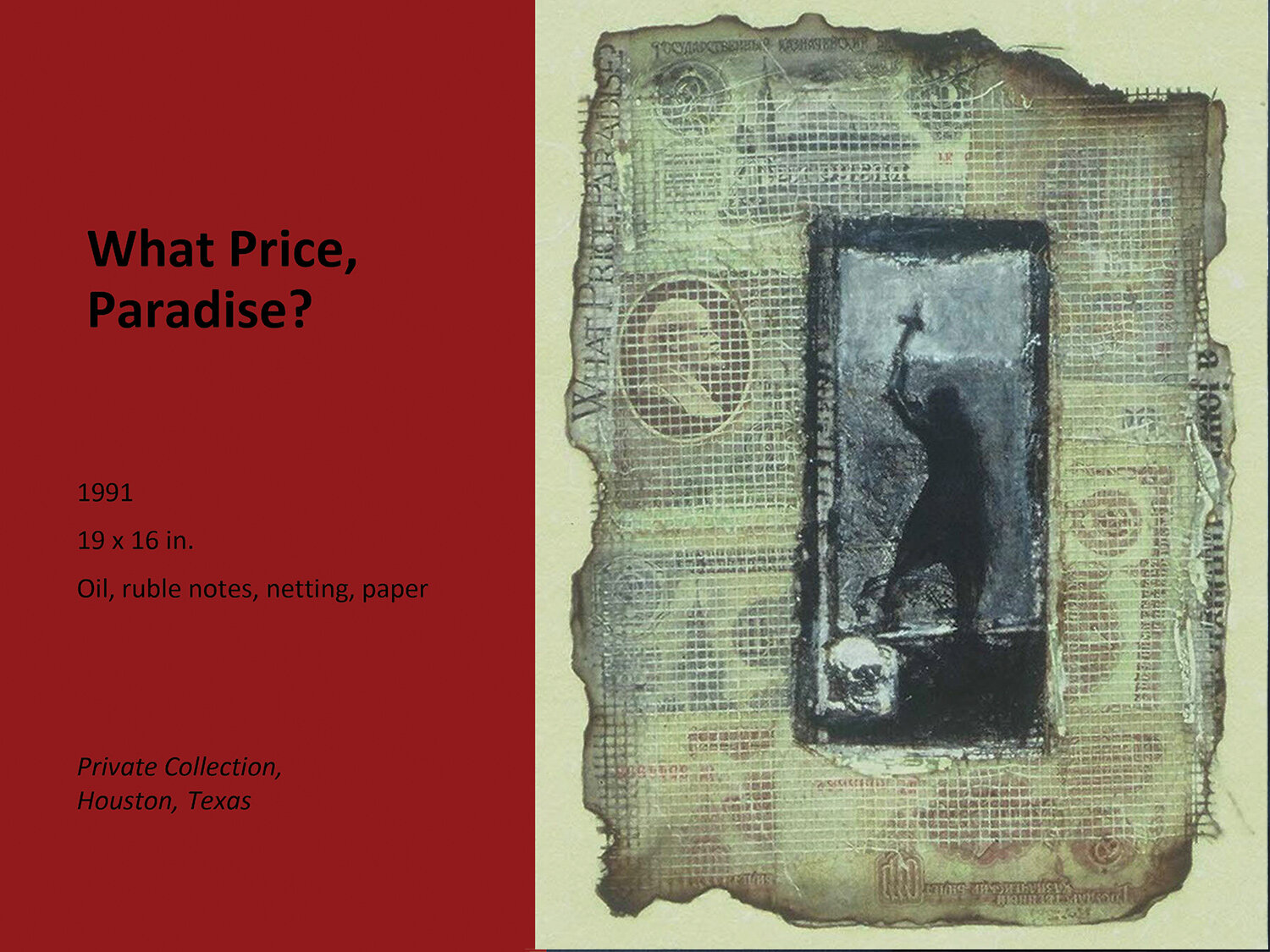

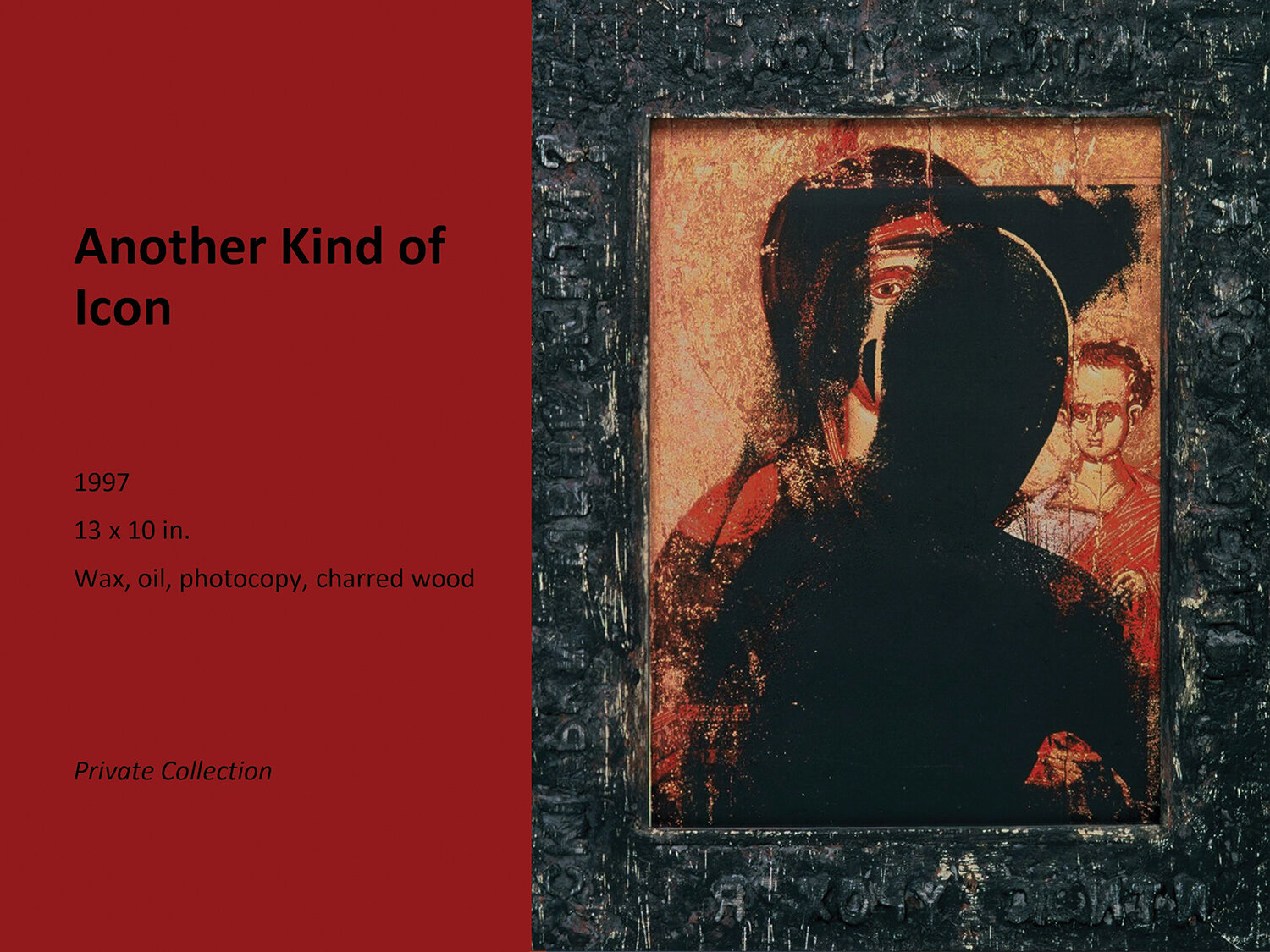



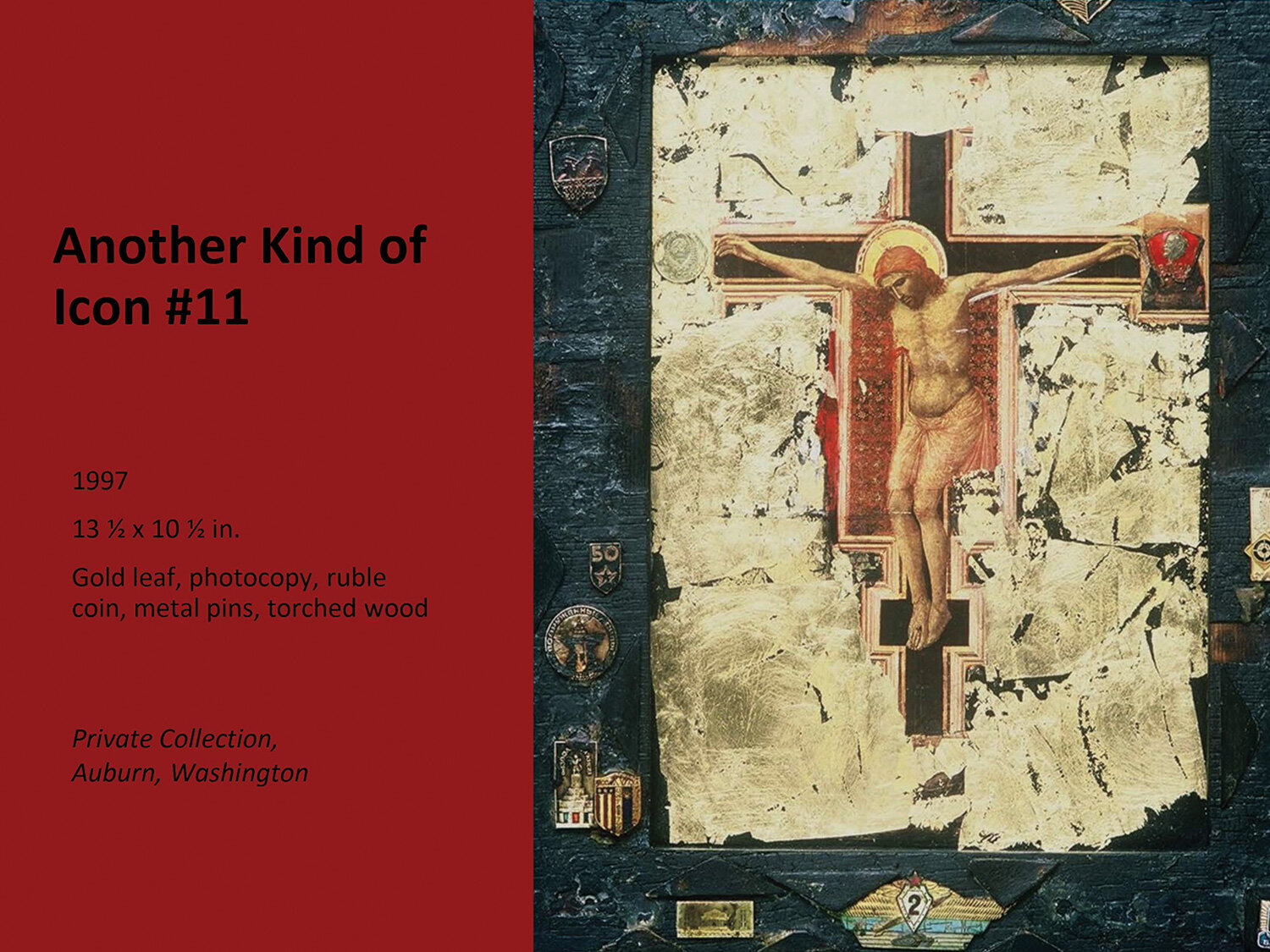













About the Artist
Lydia Bodnar-Balahutrak completed her undergraduate art studies at Kent State University, studied at the Corcoran School of Art and received her Master of Fine Arts degree in painting from George Washington University, Washington, D.C. Born and raised in Cleveland, Ohio, she moved to Houston in 1977, where she continues to live and work.
An IREX grant enabled her to travel to Ukraine for the first time in 1991. Five years later she visited the Chornobyl Zone. These trips marked turning points in her creative work and world view. A concern with the human condition –always at the heart of her art –took new form and urgency. Her current work continues to explore narrative and cultural metaphor by combining collage, text and figuration.
Since 1991, the artist has participated in several national and international exhibitions and has been awarded artist residencies in France, Ukraine and U.S. venues. Her work can be found in museum and private collections in the USA and Europe, including The Museum of South Texas and Oxford University. A monograph focusing on her art from 1979-2001 was published in 2005.Planned for 2021-22, a year-long traveling solo exhibition of her work opens at the National Museum in Lviv, Ukraine, and continues to art venues in Chernivtsi, Lutsk, Kyiv and Kharkiv.
Lydia Bodnar-Balahutrak is on the Studio School Faculty of the Glassell School of Art, Museum of Fine Arts, Houston.
For more information about her work, visit: www.LydiaBodnarBalahutrak.com
Bibliography
Lydia Bodnar-Balahutrak’s ‘dialogues’ November 2, 2015 to January 4, 2016, Lone Star College-Kingwood Fine Art Gallery, Video, 20:19, 5/3/2017 (Interview) https://www.youtube.com/watch?v=Cm9sD4xP-WU
Houston Artist Tribe Video Series with Kay Sarver, Episode 31: Lydia Bodnar-Balahutrak, Video, 41:55; 12/17/2019 (Interview) https://www.youtube.com/watch?v=sxBpQfzC7Bw
“Evocations: Works by Lydia Bodnar-Balahutrak,” Ukrainian Museum, New York, 2013 (Exhibition Brochure)
Genocide: Man’s Inhumanity to Mankind, September 30, 2016 – January 1, 2017, Holocaust Museum, Houston, 2016 (Exhibition Catalogue)
Stanislav Grezdo and Adrienne Kochman, Artists Respond to the Genocide, Ukrainian Institute of Modern Art, Chicago, 2013 (Exhibition Catalogue)
Myroslava Mudrak, “Where have all the mallows gone?” in Tangled Roots, Bowling Green State University, October 13-November 3, 1995 (Exhibition Catalogue)
Susie Tommaney, “An Artist’s Exploration of the Crisis in Ukraine Begins by Remembering the Past,” Houston Press, February 24, 2015.
Selected Resources: Books
Robert Conquest
The Harvest of Sorrow: Soviet Collectivization and the Terror-Famine
Oxford University Press
1986
Miron Dolot
Execution by Hunger: The Hidden Holocaust,
W. W. Norton & Co.
1985
Anne Applebaum
Red Famine: Stalin’s War on Ukraine
Anchor Books
2017
Selected Resources: Film
Harvest of Despair: The Unknown Holocaust
IMDb, 1985, 2004
Bitter Harvest,
IMDb 6.0, 2017
Mr. Jones,
IMDb 6.8, 2020
Acknowledgments
The exhibition Holodomor: A Remembrance originated in Texas where the artist Lydia Bodnar-Balahutrak resides. It was conceived by members of the Ukrainian-American community in Texas.
All images and works of art in this exhibition were provided by permission and courtesy of the artist. We thank Lydia for her collaboration and input. The images of works within this presentation may not be reproduced or used without permission from the artist.
Sincere thanks to the venues within and outside of Texas that are graciously hosting and sharing this virtual presentation in November 2020 for the 87th anniversary of the Holodomor Genocide in Ukraine.
The exhibition Holodomor: A Remembrance© was developed by Roksolana Karmazyn, Chrystia Bryndzia, Ksenia Rychtycka, Anizia Karmazyn and Olya Czerkas.
Thank You to the Exhibition Venue and Promotional Partners
Academic Partners
Boniuk Institute at Rice University
Center for Russian, East European, and Eurasian Studies at the University of Pittsburgh
Fresno State University, History Department
Ukrainian Studies Program at the Harriman Institute, Columbia University
University of Alberta Canadian Institute of Ukrainian Studies
Museum, Arts and Cultural Center Partners
Ukrainian Art Center Inc., Los Angeles
Ukrainian American Archives & Museum, Detroit
Ukrainian Educational and Cultural Center, Philadelphia
Ukrainian History and Education Center (UHEC), Somerset
Ukrainian Institute of America, New York
Ukrainian Museum-Archives, Cleveland
The Ukrainian Museum, New York
Ukrainian National Museum, Chicago
Domestic and International Partners
Razom for Ukraine Culture Calendar, New York
San Antonio Council for International Visitors
South Dakota World Affairs Council, Brookings
Ukrainian Association of North Carolina
Ukrainian Canadian Congress National, Winnipeg-Ottawa
Ukrainian Catholic Eparchy of Saskatoon
Ukrainian Genocide Famine Foundation USA, Chicago
U.S. Committee for Ukrainian Holodomor-Genocide Awareness, Washington, D.C.
World Affairs Council of San Antonio
Ukrainian National Women’s League of America (CYA)
Br. #3, Phoenix, Arizona
Br. #17, Miami, Florida
Br. #50, Ann Arbor, Michigan
Br. #56, North Port, Florida
Br. #76, Warren, Michigan
Br. #96, Warren, Michigan
Br. #97, Buffalo, New York
Br. #107, San Jose, California
Br. #118, Houston, Texas
Br. #120, Rochester, New York
Br. #124, St. Petersburg, Florida
Florida Community Partners
Assumption of the Blessed Virgin Mary Ukrainian Catholic Church, Miami
Epiphany of Our Lord Ukrainian Catholic Church, St. Petersburg
Ukrainian American Club of Miami
Ukrainian Dancers of Miami
Michigan Community Partners
Detroitski Novyny/Ukrainian Metro News
Shevchenko Scientific Society, Detroit Chapter
Ukrainian American Holodomor Genocide Committee of Michigan, UACC, Warren
Ukrainian Selfreliance Michigan Federal Credit Union, Warren
Texas Community Partners
Austin Tx Ukrainians
Brazos Valley Worldfest 2020, Bryan
Holodomor-The Ukrainian Genocide, Austin
Pokrova Mother of God Ukrainian Catholic Church, Houston
Texas Council of Social Studies
Ukrainian American Cultural Club of Houston
Ukrainian American Society of Texas, Dallas
Ukrainian San Antonio
Ukrainian Society of San Antonio


























